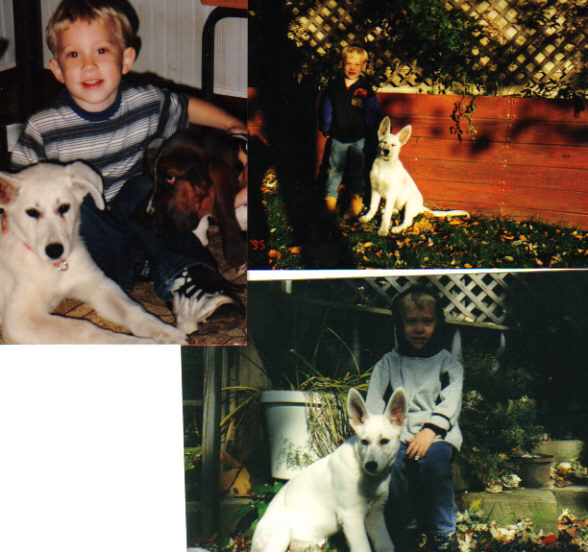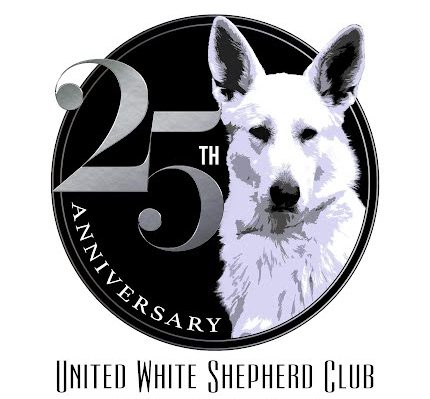
The following article was written by Dale Maloney for the United White Shepherd Club and published in the UKC Bloodlines monthly magazine:
One of the most common questions asked about the White Shepherd is “How are they with children?” This is probably also true for most all breeds. And lovers of most breeds will surely answer that “they are GREAT with children!” Of course they are! Dogs wouldn’t be known as “man’s best friend” if they weren’t. If only children were as good with dogs as dogs are with children.
Sensational and extreme cases aside, I come from the position that a healthy dog – reasonably socialized with children – would not harm a child without believing it has a good reason to. (More on that statement throughout)
What concerns you? There are many factors to be considered when evaluating what makes a dog good with children. Temperaments can range from docile and tolerant of everything, to hyper and/or aggressive. I believe the importance of temperament varies inversely with the dog’s size; an aggressive Pug being much more tolerable than a hyperactive Newfoundland. While I find humor in a peeved Pug, I shudder at the thought of being near a wound-up, 180 lb. Newfy. And the respectable size of a White Shepherd does bring merit to the question of whether these dogs are good with children.
While accidental damage of any kind can be greater than with a small dog, White Shepherds also have extremely powerful jaws. Care must be taken with puppies of any breed until they mature past the chew-everything stage. And keep in mind that if you do not ensure a young pup has plenty of attention and opportunity to play, you are inviting problems. Instead of a damaged shoe – which all dogs seem drawn to chew – you may find your kitchen table missing a leg.
White Shepherds that receive love, attention, and training are amazingly adept at learning which toys are theirs, and everything else is not. This continuously amazes me, as I have failed miserably to keep my children’s toys from populating the entire house. Despite constant availability, the kid’s toys are ignored. To my great relief, my White Shepherd learns immediately that a toy given to her is hers and stuffed animals are not.
The rules change outside however, and I am not the boss of the yard. Anything that hits the ground outside becomes a toy. For the same reason they want to chew our shoes, my work gloves are a special treat. Inside the house they are safe, but I really believe the dogs stalk me in the yard, and if I set my gloves down for a moment, they’re gone!
Other concerns people have when choosing a breed for children are:
Are they friendly? Are they playful?
Are they highly tolerant of the relentless and infinite number of ways a child will test a dog’s patience?
To each of the above questions, yes is the answer. I must add though, that a friendly White Shepherd is not friendly like a Golden Retriever. This is not a breed that is excited to have the attention of whatever human is available. Many White Shepherds are even cautious of accepting treats from strangers. But if you’re an insider to the family, expect to be thoroughly loved.
if you are looking for a best friend for your child, give your child a White Shepherd puppy and be sure they get more time together than with anyone else. White Shepherds love their whole family, but they really love their master, tending to choose a favorite. My girl wants to be with me over anyone else in the house. This is very frustrating to my daughters when I’m home and they want to play with her.
But are they trustworthy?
This question is most important for a concerned parent to ask. I wouldn’t be a member of the UWSC if I weren’t confident in answering “yes.” I am especially enthusiastic about this, and the reason is a fascinating one to me. It lies in their unique combination of inherited instincts and their proven, superior intelligence. The combined package equips the White Shepherd to bring a surprising ability to discern a situation. Yes, I said “discern.”
They are not THE smartest dogs, ONLY ranking 3rd on the list created by neuropsychologist, Stanley Coren, and published in his book, The Intelligence of Dogs. But although I am proud of the extreme intelligence the White Shepherd maintains from it’s German Shepherd heritage, it is how that intelligence is used which is truly exceptional. First of all is the herding instinct, which is shared with the #1 dog on the list, the Border Collie. Now parents may jump with joy at the thought of their dog containing their children, but this is actually rare and not my point.
The herding instinct is at least one explanation for their keen attentiveness, but this is only one part of their foundation. The German Shepherd heritage also uniquely includes a guard instinct, and indeed a whole host of traits (from an especially keen nose, to fierce loyalty and love for mankind) that have earned them the reputation of most versatile of all breeds. It is this diversity which I believe makes this breed uniquely reliable with children. (At this point I absolutely MUST add the clause, “when properly bred for temperament and properly socialized.”)
I give to you the following example, cited by Dr. Michael Fox in his book, Superdog, Raising the Perfect Canine Companion. He describes a German Shepherd that was “so protective of “her” children that she would stop them from playing too wildly with the neighbor children if the latter seemed to be threatening those of her family.” This is a comment that is unexceptional. Lovers of many breeds would identify with it.
What IS exceptional follows. “Fortunately, this dog was sufficiently aware, rational, and understanding that it did not injure or even scare the other children. But other, less intelligent dogs often will frighten, if not injure, others’ children… Most dogs are biologically unreliable.” That is an astounding statement! I am very confident that my children are actually safer outside with our White Shepherd, and also confident that unexpected visitors will receive only a warning unless they make it clear they are a threat.
Despite my confidence, I recommend caution at even the thought of allowing any dog to play unsupervised with small children, especially children unfamiliar to the dog. But when selecting a family pet, it was critical to me that I start with a breed known for accurately evaluating friend or foe. The next critical factor is choosing a breeder known to diligently select for proper temperament.
One of my favorite activities for both the kids (ages 1 & 4) and the dogs is to visit the playground. I am always pleased to note the White Shepherd is very aware of their location and what is happening around them, and also amazingly confident that the swarming, squealing children are no threat to her. It seems that very few children are taught to wisely approach a dog they’ve never met and properly introduce themselves, but never have I seen my White Shepherd show any aggressive response to being improperly approached by a child, no matter how enthusiastically.
I must say that the case is very different with adults behaving strangely or anyone that is perceived to be a threat to my children. That is where the protective instinct kicks in, and it is here where different breeds, and bloodlines within breeds, really show their mettle. (Merriam Webster – quality of temperament or disposition) This is where intelligence, instinct, TRAINING, and breeding culminate into a reaction. The breed determines much of what to expect of intelligence and instinct. The rest measures the owner and the breeder. Yes, we are a BIG part of the equation, and irresponsible training or selection in breeding can quickly result in dogs that do not display proper temperament.
So what should a parent do? Regardless of how intelligent is the mind and sharp are the instincts, a dog must be trained in basic obedience and socialized to children. Even more important is to train your children to respect and handle the dog. Of course we can’t expect a young child to understand canine behavior, but this point was truly emphasized to me when I heard my daughter yell, “NO, Sky! I told you, yours is the BLUE ONE!” Simply put, children do not naturally understand how to properly treat animals, or even other children. They must be taught to be gentle, lest one or both be hurt.
Socializing a puppy to children is very simple to do, but I recommend you wait until a pup is 3-4 months old before exposure to possibly frightening environments. Just go where kids are, and kids will come to the dog. Be sure to control the situation though, as young children are often less predictable than dogs.
Introducing babies to a family already owning a dog is a different matter. In this case it is best to imagine the dog as a child, complete with jealousy and frustration at all the changes that happen and loss of attention. And many times a dog that is socialized to children will not have encountered an infant or toddler before. The rules are totally different with these little ones. “Paws off!” is the rule. Most importantly, the dog needs to learn that the baby is under your protection. You still love the dog, but there’s a new pecking order, and the baby ranks unquestionably higher than the dog. Also keep in mind you need to ensure the dog gets enough personal attention.
Even a tender and loving White Shepherd can accidentally injure a baby with a misplaced paw. I do not fear anything intentional. It is the simple fact that a White Shepherd will weigh from 65 to 110 pounds – 10 times, maybe more, the weight of a baby. Imagine if you were only 2 feet tall, that bushy tail would seem like a tree being swung at you. And imagine finding yourself being caught broadside in an excited, “glad you’re home” spin. The image in my mind is like the fight scenes in the Matrix. You wouldn’t just be knocked over. You’d be launched into the wall. So follow the paws off rule until the baby is at least 2 years old and your problems will be minimized.
My younger daughter is 18 months old as I write this, and once our White Shepherd is settled down from the excitement of coming inside, I let them be together. Jessica loves our pets, giving them plenty of hugs and kisses. As for Sarah? I’ve long feared more for the animals than for her, and it is fortunate they are so tolerant of her abuse. Just when I think I’ve finally taught her not to incite the dogs to chase her, she’s at it again.
